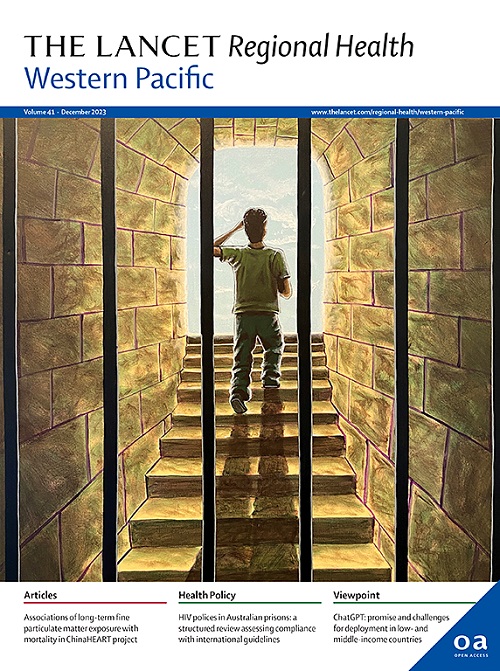Genetic factors driving the Mycoplasma pneumoniae outbreak among children post-COVID-19 in China: a whole genome analysis
IF 7.6
1区 医学
Q1 HEALTH CARE SCIENCES & SERVICES
引用次数: 0
Abstract
Background
Mycoplasma pneumoniae (M. pneumoniae) is a leading cause of community-acquired pneumonia in children. Post-COVID-19, a significant resurgence of M. pneumoniae infections has been observed in China, but whole-genome analyses on the genetic mechanisms driving this resurgence remain limited.
Methods
We performed whole-genome sequencing on 169 M. pneumoniae isolates from Beijing and Baoding, collected before and after COVID-19. All M. pneumoniae genomes from GenBank were included for analysis. Genotypes were identified using multilocus variable-number tandem-repeat analysis (MLVA), multilocus sequence typing (MLST), phylogenetic analysis. Genomic conservation and transmission patterns were assessed via SNP distance.
Findings
We identified a post-COVID-19 resurgence of M. pneumoniae infections among children, with infection rates peaking at 60%–70% in late 2023, higher than during the pandemic (10%–20%) and pre-pandemic (∼30%). Genomic analysis revealed distinct genotypes, with T1-2 (4-5-7-2) dominating in Beijing, and both T1-2 and T2-2 (3-5-6-2) prevalent in Baoding. Minimal SNP distances and genomic conservation indicated rapid spread of M. pneumoniae. Genomic analysis uncovered key genetic factors driving the outbreak: near-100% macrolide resistance and increased prevalence of the 4-5-7-2 genotype (enriched in virulence and metabolism-related genes).
Interpretation
This study provides a comprehensive genomic analysis of genetic factors driving the outbreak. With near-100% macrolide resistance in China, urgent changes in treatment policies are needed. The rising prevalence of 4-5-7-2 and its functional advantages warrant close monitoring. Our findings offer insights into the outbreak causes and guide future prevention and control strategies.
Funding
National Key R&D Program of China; Training Plan for High level Public Health Technical Talents.
新冠肺炎后中国儿童肺炎支原体暴发的遗传因素:全基因组分析
肺炎支原体是儿童社区获得性肺炎的主要病因。在2019冠状病毒病后,中国观察到肺炎支原体感染的明显复苏,但对这种复苏的遗传机制的全基因组分析仍然有限。方法对在北京和保定两地采集的169株肺炎支原体进行全基因组测序。纳入GenBank中所有肺炎支原体基因组进行分析。采用多位点可变数串联重复分析(MLVA)、多位点序列分型(MLST)和系统发育分析鉴定基因型。通过SNP距离评估基因组保护和传播模式。研究结果:我们发现儿童肺炎支原体感染在covid -19后再次出现,感染率在2023年底达到60%-70%的峰值,高于大流行期间(10%-20%)和大流行前(~ 30%)。基因型分析表明,北京地区以T1-2(4-5-7-2)为主,保定地区以T1-2和T2-2(3-5-6-2)为主。最小SNP距离和基因组保守表明肺炎支原体的快速传播。基因组分析揭示了导致疫情的关键遗传因素:近100%的大环内酯耐药性和4-5-7-2基因型(富含毒力和代谢相关基因)的流行率增加。本研究对导致疫情的遗传因素进行了全面的基因组分析。由于中国大环内酯类药物耐药性接近100%,迫切需要改变治疗政策。4-5-7-2的日益普及及其功能优势值得密切关注。我们的研究结果为了解爆发原因提供了见解,并指导了未来的预防和控制策略。国家重点研发计划;高层次公共卫生技术人才培养计划。
本文章由计算机程序翻译,如有差异,请以英文原文为准。
求助全文
约1分钟内获得全文
求助全文
来源期刊

The Lancet Regional Health: Western Pacific
Medicine-Pediatrics, Perinatology and Child Health
CiteScore
8.80
自引率
2.80%
发文量
305
审稿时长
11 weeks
期刊介绍:
The Lancet Regional Health – Western Pacific, a gold open access journal, is an integral part of The Lancet's global initiative advocating for healthcare quality and access worldwide. It aims to advance clinical practice and health policy in the Western Pacific region, contributing to enhanced health outcomes. The journal publishes high-quality original research shedding light on clinical practice and health policy in the region. It also includes reviews, commentaries, and opinion pieces covering diverse regional health topics, such as infectious diseases, non-communicable diseases, child and adolescent health, maternal and reproductive health, aging health, mental health, the health workforce and systems, and health policy.
 求助内容:
求助内容: 应助结果提醒方式:
应助结果提醒方式:


